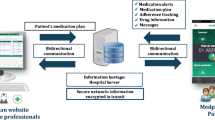Abstract
Medication adherence is essential for the success of home care. However, it is hard to achieve in reality. In this paper, we propose a bidirectional medication assistance system that is composed of a sensor-enabled pill box and a photo message system. While most of the existing medication assistance systems enhance medication adherence by properly alerting the patients; our bidirectional system does it by the enhancement of information sharing and communications between patients and medical staff. The medication dosage states of a patient are detected by a hall-effect sensor attached to the lid of an off-the-shelf pill box. The sensor data is transferred over a ZigBee network located in the patient’s home and is stored in a cloud database through a 3G mobile network. Since the raw sensor data might contain erroneous open-close events of the pill box, we developed a data filtering function to eliminate the false-positive events. With the data filtering function, we improved the accuracy of medication monitoring from 60% to 85% during our three-month experiment involving seven patients. In addition, we evaluated the effectiveness of the photo message system that home visiting nurses can use to communicate with the patient. The missed medication ratio was improved from 15% to 4% after the photo message system was installed. The effectiveness of the photo message system continued for two months after the initiation. We also interviewed 15 medical staff about the effectiveness of the medication monitoring with the sensor-enabled pill box and the photo message system.
Similar content being viewed by others
References
World Health Organization, Adherence to Long-Term Therapies: Evidence for Action. Geneva: WHO, 2003.
E. Sabate, Adherence to Long-Term Therapies: Evidence for Action. Geneva: WHO, 2003, pp. 3–9
D. M. Cutler and W. Everett, “Thinking outside the pillbox-A system-wide approach to improving patient medication adherence for chronic disease,” N. Engl. J. Med., vol. 362, no. 17, pp. 1553–1555, Apr. 2010.
C. Obata, T. Tanaka, and H. Goto, “Factor analysis and the reliability and false declaration of value in self-reported SMBG,” Association for the Study of Innovative Diabetes Treatment in Japan, vol. 5, pp. 12–15, 2009.
K. Hasegawa, Y. Kuritani, A. Adachi, K. Shinke, S. Nishii, and Y. Fujita, “Improvement of drug compliance and pharmaceutical care: Types of drug and dosing regimens desired by patients,” Japanese J. Pharmaceutical Health Care and Sciences, vol. 34, no. 8, pp. 800–804, Aug. 2008.
Japan Pharmaceutical Association, Research Report of the Effects and Home Care Management Guidance-Medication Problems for Elderly Management Guidance of Counseling Home Care, (in Japanese), 2008.
Institute for Health Economics and Policy, Study of the Factors Helping the Elderly Who Require Nursing Care to Live at Home. Ministry of Health, Labour and Welfare, Mar. 2011.
A. Dohr, R. Modre-Osprian, M. Drobics, D. Hayn, and G. Schreier, “The internet of things for ambient assisted living,” in Proc. 7th Int. Conf. Information Technology: New Generations. Washington DC: IEEE Computer Society 2010, pp. 804–809.
S. Consolvo, P. Roessler, and B. E. Shelton, “The CareNet display: Lessons learned from an in home evaluation of an ambient display,” in Proc. 6th Int. Conf. Ubiquitous Computing, UbiComp’ 04. Berlin: Springer, 2004, pp. 1–17.
I. Laranjoa, J. Macedob, and A. Santosb, “Internet of things for medication control: Service implementation and testing,” in Proc. 4th Conf. of ENTERprise Information Systems-Aligning Technology, Organizations and People (CENTERIS 2012), Procedia Technology, vol. 5, pp. 777–786, 2012.
A. Möller, S. Diewald, L. Roalter, and M. Kranz, “MobiMed: Comparing object identification techniques on smartphones,” in Proc. 7th Nordic Conf. Human-Computer Interaction: Making Sense Through Design. New York: ACM, pp. 31–40, 2012.
A. J. Jara, M. A. Zamora, and A. F. Skarmeta, “Drug identification and interaction checker based on IoT to minimize adverse drug reactions and improve drug compliance,” Pers. Ubiquit. Comput., doi: 10.1007/s00779-012-0622-2, 2012.
A. J. Jara, M. A. Zamora, and A. F. Skarmeta, “Knowledge acquisition and management architecture for mobile and personal health environments based on the Internet of Things,” in Proc. IEEE 11th Int. Conf. Trust, Security and Privacy in Computing and Communications (TrustCom), Liverpool, UK, 2012, pp. 1811–1818.
E. Barclay, “Text messages could hasten tuberculosis drug compliance,” The Lancet, vol. 373, no. 9657, pp. 15–16, Jan. 2009.
D. Chandler, “Smart pillbox could be a lifesaver,” MIT TechTalk, vol. 52, no. 15, pp. 2–3, Feb. 2008.
H. Yu, C. Tang, and R. Bashirullah, “Asymmetric RF tags for ingestible medication compliance capsules,” in Proc. Symp. VLSI Circuits, Kyoto, Japan, vol. 14, pp. 34–35, 2009.
A. Agarawala, S. Greenberg, and G. Ho, “The Context-Aware Pill Bottle and Medication Monitor,” in Video Proc./Supplement of Proc. 6th Int. Conf. Ubiquitous Computing, UbiComp’ 04. Berlin: Springer, 2004.
L. T. Hayes, M. J. Hunt, A. Adami, and A. J. Kaye, “An electronic pillbox for continuous monitoring of medication adherence,” in Proc. Engineering in Medicine and Biology Society (EMBS), 2006, pp. 6400–6403.
S. Suzuki, T. Yokoishi, H. Hada, J. Mitsugi, O. Nakamura, and J. Murai, “Medication management using home sensor network toward expanding home health care (proving test in home care),” (in Japanese), Information Processing Society of Japan, vol. 28, pp. 1–8, 2010.
S. Suzuki, T. Yokoishi, H. Hada, J. Mitsugi, O. Nakamura, and J. Murai, “Bidirectional medication support system for medical staff and home care patients,” in Proc. 5th Int. Symp. Medical Information and Communication Technology (ISMICT), 2011, pp. 147–151.
Author information
Authors and Affiliations
Corresponding author
Rights and permissions
About this article
Cite this article
Suzuki, S., Mitsugi, J. & Murai, J. Improving medication adherence in home care using a bidirectional medication assistance system. Netw.Sci. 3, 63–70 (2013). https://doi.org/10.1007/s13119-013-0020-8
Received:
Revised:
Accepted:
Published:
Issue Date:
DOI: https://doi.org/10.1007/s13119-013-0020-8




